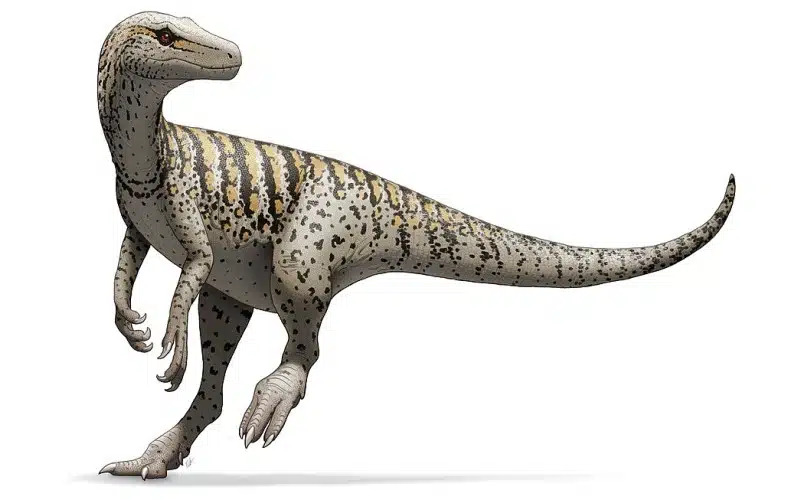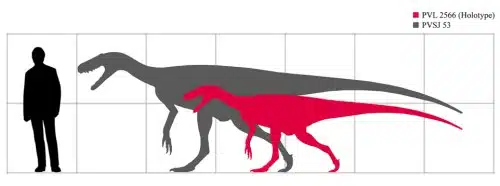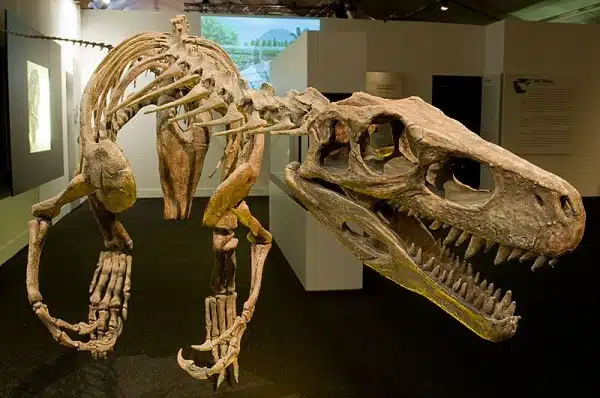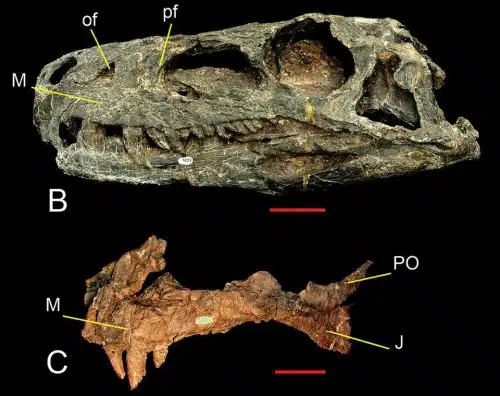The Late Triassic was a time of immense change, where the first dinosaurs arised and started to diversify. Among these early pioneers was Herrerasaurus, a sleek and agile predator that roamed what is now Argentina. As one of the earliest possible theropods (its phylogenetic position is debated), it provides crucial insights into the dawn of dinosaur evolution.
Herrerasaurus Key Facts
| Keyword | Fact |
|---|---|
| Pronunciation | heh-RAY-ruh-SORE-us |
| Meaning of name | Herrera’s Lizard |
| Group | Dinosauria |
| Type Species | Herrerasaurus ischigualastensis |
| Diet | Carnivore |
| When it Lived | 237.0 to 227.0 MYA |
| Period | Late Triassic |
| Epoch | Carnian |
| Length | 20.0 feet |
| Height | 5.0 feet at the hips |
| Weight | 770.0 pounds |
| Mobility | Moved on two legs |
| First Discovery | 1959 by Victorino Herrera |
| Described by | 1963 by Osvaldo Reig |
| Holotype | PVL 2566 |
| Location of first find | Hoyada de Ischigualasto, Ischigualasto Provincial Park, San Juan Province, Argentina |
Herrerasaurus Origins, Taxonomy, and Timeline
The name Herrerasaurus is a tribute to Victorino Herrera, an Andean goatherd who first discovered its fossils in Argentina in 1959. The second part of its name, “saurus,” comes from the Greek word sauros, meaning “lizard,” a common suffix in dinosaur names.

Taxonomically, Herrerasaurus belongs to the family Herrerasauridae, a group of early dinosaurs that once puzzled paleontologists due to their mix of primitive and advanced traits. The phylogenetic position of Herrerasaurus is debated.
Herrerasaurus roamed the Earth during the Carnian (Late Triassic Period, 237.0 to 227.0 million years ago), a time when dinosaurs were only beginning to establish themselves (the earliest dinosaur Nyasasaurus, from 243 million years ago). This period was critical, as dinosaurs started to diversify in a world still dominated by other archosaurs groups. Living long before the towering theropods of later periods, Herrerasaurus was one of the first significant carnivores to take its place in the prehistoric ecosystems of what is now South America.
Discovery & Fossil Evidence
The first remains of Herrerasaurus were discovered in 1959 by Victorino Herrera, an Andean goatherd (the equivalent of a shepherd for goats), near San Juan, Argentina, in the Ischigualasto Formation, a region known for preserving Late Triassic fauna, including Eoraptor. Paleontologist Osvaldo Reig formally described Herrerasaurus in 1963, naming it after Herrera.
For years, the classification of Herrerasuaurus was speculative, as it was known from very fragmentary remains. Initially, Reig classified Herrerasaurus as a carnosaur, but some paleontologists, like Peter Galton in 1972, even questioned whether it could be diagnosed beyond Saurischia. Others, using cladistic analysis, suggested it belonged to an early branch of dinosaurs, possibly before the split between saurischians and ornithischians. Some researchers even classified it as a non-dinosaur archosaur.
In 1988, a complete Herrerasaurus skull was discovered and later studied by Paul Sereno. Sereno argued that Herrerasaurus was a primitive theropod, a classification supported by ichnological evidence from the Los Rastros Formation, which predates Herrerasaurus and suggests early theropod-like dinosaurs already existed.
Lately, modern phylogenetic work has placed it as either an early form of theropod (Hendricks et al., 2015) or an early-diverging saurischian (Norell et al., 2017), which seems to be the most accepted hypothesis for now.
Frenguellisaurus ischigualastensis (described in 1986) and Ischisaurus cattoi (described in 1963) have been synonymised with Herrerasaurus.
- Skeleton replica at a special exhibition of the Naturmuseum Senckenberg
- Skeleton of Herrerasaurus
- Skull of Herrerasaurus (PVSJ 407) in left lateral view (B) Left maxilla of Herrerasaurus (PVSJ 053) in lateral view (C)
- Herrerasaurus skull cast at the Melbourne Museum
Herrerasaurus Size and Description
In the Late Triassic, Herrerasaurus was among the earliest predatory dinosaurs. With a lightweight yet muscular frame, it was built for speed and efficiency, capable of chasing down prey with precision. Its combination of sharp teeth, strong limbs, and a long, stabilizing tail made it a highly effective hunter in its prehistoric ecosystem.
Short Description of Herrerasaurus
Sleek and streamlined, Herrerasaurus was a bipedal predator with a long, narrow skull lined with serrated teeth designed for slicing through flesh. Its strong yet relatively short arms ended in three-fingered, clawed hands, which it likely used to seize struggling prey before delivering a fatal bite. The structure of its vertebrae, along with its long, whip-like tail, suggests it was well-balanced, allowing for swift and controlled movements while pursuing prey.
Its hind limbs were powerful and built for speed, indicating that it was a fast runner capable of short bursts of high velocity to ambush its targets. The dinosaur’s overall body structure suggests it had excellent maneuverability, crucial for navigating the dense forests of Late Triassic South America. While fossil evidence of its skin is lacking, it may have had a scaly covering similar to other early theropods, providing protection and aiding in thermoregulation.
Size and Weight of Type Species
Herrerasaurus ischigualastensis measured approximately 20.0 feet in length, making it one of the larger carnivores of its time, though still smaller than the dominant theropods of later periods. It stood at an estimated 5.0 feet at the hips, allowing it to maintain a high vantage point while scanning for prey in its environment. Its body proportions indicate a predator built for pursuit, relying on speed and agility rather than brute strength alone.

Weighing around 770.0 pounds, Herrerasaurus ischigualastensis was relatively lightweight for its size, a key factor in its agility and swift predatory tactics. Its long legs and lean build suggest it was an efficient runner, capable of sustaining high speeds to chase down smaller herbivores. Unlike bulkier carnivores that relied on ambush tactics, Herrerasaurus ischigualastensis likely engaged in pursuit predation, using its speed and reflexes to capture prey.
Some variation exists in size estimates due to differences in fossil specimens, but most reconstructions consistently place it within these dimensions. As one of the dominant predators of the Late Triassic, it played a crucial role in its ecosystem, filling the niche of a fast, agile hunter before the rise of larger theropods in later periods.
The Dinosaur in Detail
Herrerasaurus was a fascinating blend of primitive and advanced traits, showcasing an early stage in dinosaur evolution. The cervical vertebrae are elongated with well-developed epipophyses. The dorsal vertebrae are amphicoelous (meaning that both the posterior and anterior ends of the centrum are concave). Like most dinosaurs, it has 3 fused sacral vertebrae, blending with the pelvic bones.
Its powerful hind limbs were built for speed, suggesting it relied on rapid bursts of movement to chase down prey. The femur is long, while the tibia is shorter but stronger. The pes (foot), has five fingers, but only four seem to be functional (the first digit is reduced). The pubis, one of the pelvic bones, is long and curved forward. The ischium, however, seem to be shorter than the pubis.
On the forelimb, Herrerasaurus displays a slender and slightly curved scapula, and the coracoid is rounded with a small foramen. The humerus, robust and slightly curved, connects to the elongated radius and ulna. At the distal end of the forelimb, the manus (hand) displays five fingers, with three being the most developed.
The skull of Herrerasaurus is long and narrow, housing sharp, serrated teeth perfect for slicing through flesh, a hallmark of carnivorous adaptation. Fossils indicate that it was an active hunter, not just a scavenger, filling an important role as one of the top predators in its ecosystem. Notable specimens, including the nearly complete skull discovered in 1988 by Paul Sereno’s team, have greatly contributed to our understanding of its anatomy and evolutionary significance.
Interesting Points about Herrerasaurus
- Herrerasaurus is one of the oldest known dinosaur, providing key insights into their early evolution.
- It had a mix of primitive and advanced features, making its classification a topic of scientific debate for years. The debate is still not closed.
- Fossil evidence suggests it was a fast, active predator, likely using speed and agility to catch prey.
- Its grasping hands and flexible jaw hint at a specialized hunting style
Contemporary Dinosaurs
The world of Herrerasaurus was filled with other dinosaurs that shaped its ecosystem. Eoraptor, a small, lightly built dinosaur, moved through the same terrain, possibly as an omnivore feeding on small vertebrates and plants. While both belonged to the theropod lineage, Eoraptor likely occupied a different niche, scavenging and preying on even smaller creatures, demonstrating the early diversity of feeding behaviors among dinosaurs.

Sharing this environment was Staurikosaurus, another possible theropod known for its sleek frame and swift hunting abilities. Though smaller than Herrerasaurus, it was built for speed, using its agility to chase down prey. The coexistence of multiple carnivores in the same region suggests each species adapted to distinct hunting strategies, reducing direct competition.
Amidst the carnivores, Pisanosaurus, an ornithischian (or possibly a silesaurid, which is a type of no-dinosaur dinosauriform), relied on agility to evade predators. Unlike its carnivorous neighbors, this small herbivore grazed on the primitive plant life of the Late Triassic, forming an essential part of the food chain. Its presence alongside Herrerasaurus highlights the dynamic interactions between hunters and prey in this prehistoric world.
Sanjuansaurus, another close relative of Herrerasaurus, also roamed these floodplains. Sharing a similar body plan with long limbs and sharp teeth, it likely competed for the same prey. Their resemblance suggests a shared evolutionary ancestry, reflecting the rapid diversification of early theropods in the Late Triassic.
Herrerasaurus in its Natural Habitat
The world of the Late Triassic was dramatically different from today, with warm, humid floodplains, seasonal rivers, and vast forests of ferns and conifers. This lush environment provided an abundant food supply for both herbivores and carnivores, shaping a complex and competitive ecosystem.
As a carnivore, Herrerasaurus would have been an apex predator, preying on smaller reptiles, early mammals, and possibly juvenile dinosaurs. Its speed and agility allowed it to chase down prey in the dense forests and open floodplains where it roamed. The variety of prey species in its habitat ensured it had a steady food source.
Little is known about its social behavior, but it may have been a solitary hunter, relying on its keen vision and sense of smell to track prey. Its long tail likely played a role in balance, particularly when making quick turns during pursuit. This combination of physical traits made it one of the most efficient hunters of its time.
Frequently Asked Questions
It lived during the Late Triassic period, between 237.0 and 227.0 million years ago.
As a carnivore, it preyed on small reptiles, early mammals, and possibly juvenile dinosaurs.
It reached around 20.0 feet in length, stood 5.0 feet tall at the hips, and weighed approximately 770.0 pounds.
Fossils were first found in 1959 in the Ischigualasto Formation, Argentina.
There is no definitive evidence of pack hunting, but its physical traits suggest it was a solitary predator.
Its lightweight body and strong legs suggest it was a fast runner, capable of chasing down prey efficiently.
Sources
The information in this article is based on various sources, drawing on scientific research, fossil evidence, and expert analysis. The aim is to provide a comprehensive and accurate overview of Herrerasaurus. However, please be aware that our understanding of dinosaurs and their world is constantly evolving as new discoveries are made.
This article was last fact checked: Joey Arboleda, 03-01-2024
Featured Image Credit: Fred Wierum via Wikimedia Commons




